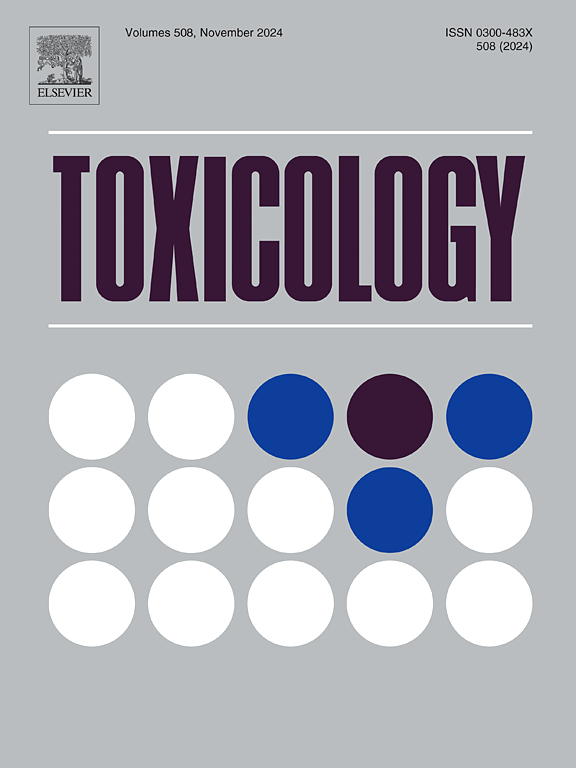汞化合物对UV-DNA损伤致突变性、遗传毒性和修复的不同影响
IF 4.6
3区 医学
Q1 PHARMACOLOGY & PHARMACY
引用次数: 0
摘要
汞(Hg)是一种全球性污染物,以甲基汞(MeHg)的形式存在于人类饮食中。最近的研究表明,接触甲基汞与皮肤癌的高风险有关。目前尚不清楚甲基汞是否对皮肤细胞具有直接的基因毒性,还是能够增强紫外线辐射的致突变作用。我们研究了甲基汞及其代谢物无机Hg2 + (iHg)的致突变性和遗传毒性,以及它们对致癌UV-DNA损伤加工的影响。我们发现iHg和MeHg在啮齿类动物CHO细胞的Hprt实验中都是非诱变的。iHg而非MeHg显著增强了UV-B的致突变性,但对致突变性环丁烷嘧啶二聚体(CPDs)的修复没有影响。在人角质形成细胞中,iHg增加了UV-B基因毒性应激和微核形成,这发生在正常和非活性核苷酸切除的细胞中,以修复UV-DNA损伤。iHg或MeHg对uvb诱导的CPDs和6-4光产物在角质形成细胞中的修复没有影响。MeHg和UV-B在人角质形成细胞中的微核形成是叠加性的,表明它们是独立的。因此,iHg(II)不具有直接的致突变性/遗传毒性,但在不干扰其修复的情况下增强了UV-DNA损伤的致突变性和致裂性。甲基汞不改变UV-B的DNA修复或致突变性/遗传毒性,但它在人角质形成细胞中起破片原的作用。本文章由计算机程序翻译,如有差异,请以英文原文为准。
Differential effects of mercury compounds on mutagenicity, genotoxicity and repair of UV-DNA damage
Mercury (Hg) is a global contaminant that is present in human diet as methylmercury (MeHg). Recent studies linked MeHg exposure with high risks of skin cancers. It is unknown whether MeHg is directly genotoxic in skin cells or able to enhance mutagenic effects of UV radiation. We examined mutagenicity and genotoxicity of MeHg and its metabolite inorganic Hg2 + (iHg) and their impact on processing of carcinogenic UV-DNA damage. We found that iHg and MeHg were both nonmutagenic in the Hprt assay in rodent CHO cells. iHg but not MeHg strongly enhanced mutagenicity of UV-B without changes in repair of mutagenic cyclobutane pyrimidine dimers (CPDs). In human keratinocytes, iHg increased genotoxic stress and formation of micronuclei by UV-B which occurred in cells with both normal and inactive nucleotide excision repair of UV-DNA damage. Repair of UVB-induced CPDs and 6–4 photoproducts in keratinocytes was unaffected by iHg or MeHg. Formation of micronuclei in human keratinocytes by MeHg and UV-B was additive, indicating their independence. Thus, iHg(II) was not directly mutagenic/genotoxic but it enhanced mutagenicity and clastogenicity of UV-DNA damage without interference with its repair. MeHg did not alter DNA repair or mutagenicity/genotoxicity of UV-B but it acted as a clastogen in human keratinocytes.
求助全文
通过发布文献求助,成功后即可免费获取论文全文。
去求助
来源期刊

Toxicology
医学-毒理学
CiteScore
7.80
自引率
4.40%
发文量
222
审稿时长
23 days
期刊介绍:
Toxicology is an international, peer-reviewed journal that publishes only the highest quality original scientific research and critical reviews describing hypothesis-based investigations into mechanisms of toxicity associated with exposures to xenobiotic chemicals, particularly as it relates to human health. In this respect "mechanisms" is defined on both the macro (e.g. physiological, biological, kinetic, species, sex, etc.) and molecular (genomic, transcriptomic, metabolic, etc.) scale. Emphasis is placed on findings that identify novel hazards and that can be extrapolated to exposures and mechanisms that are relevant to estimating human risk. Toxicology also publishes brief communications, personal commentaries and opinion articles, as well as concise expert reviews on contemporary topics. All research and review articles published in Toxicology are subject to rigorous peer review. Authors are asked to contact the Editor-in-Chief prior to submitting review articles or commentaries for consideration for publication in Toxicology.
 求助内容:
求助内容: 应助结果提醒方式:
应助结果提醒方式:


